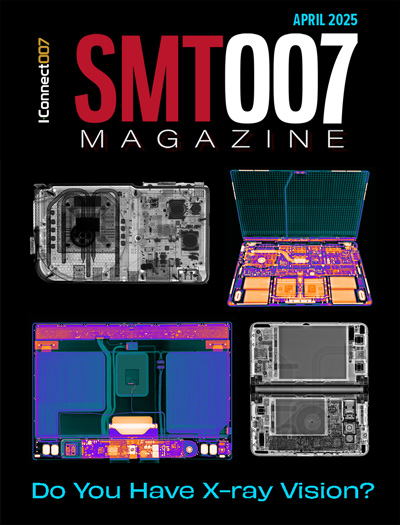-

- News
- Books
Featured Books
- smt007 Magazine
Latest Issues
Current Issue
Do You Have X-ray Vision?
Has X-ray’s time finally come in electronics manufacturing? Join us in this issue of SMT007 Magazine, where we answer this question and others to bring more efficiency to your bottom line.

IPC APEX EXPO 2025: A Preview
It’s that time again. If you’re going to Anaheim for IPC APEX EXPO 2025, we’ll see you there. In the meantime, consider this issue of SMT007 Magazine to be your golden ticket to planning the show.

Technical Resources
Key industry organizations–all with knowledge sharing as a part of their mission–share their technical repositories in this issue of SMT007 Magazine. Where can you find information critical to your work? Odds are, right here.
- Articles
- Columns
Search Console
- Links
- Media kit
||| MENU - smt007 Magazine
Global Semiconductor Fab Capacity Projected to Expand 6% in 2024 and 7% in 2025
June 18, 2024 | SEMIEstimated reading time: 2 minutes
To keep pace with unremitting growth in demand for chips, the global semiconductor manufacturing industry is expected to increase capacity by 6% in 2024 and post a 7% gain in 2025, reaching a record capacity high of 33.7 million wafers per month (wpm: 8-inch equivalent), SEMI announced today in its latest quarterly World Fab Forecast report.
Leading-edge capacity for 5nm nodes and under is expected to grow 13% in 2024, chiefly driven by generative artificial intelligence (AI) for data center training, inference, and leading-edge devices. To increase processing power efficiency, chipmakers including Intel, Samsung, and TSMC are poised to start production of 2nm Gate-All-Around (GAA) chips, boosting total leading-edge capacity growth by 17% in 2025.
“The proliferation of AI processing, from cloud computing to edge devices, is fueling the race to develop high-performance chips and driving a robust expansion of global semiconductor manufacturing capacity,” said Ajit Manocha, SEMI president and CEO. “This creates a virtuous cycle: AI will drive the growth of semiconductor content across a diverse range of applications, which in turn encourages further investment.”
Capacity Expansion by Region
Chinese chipmakers are expected to maintain double-digit capacity growth, registering a 14% increase to 10.1 million wpm in 2025 – nearly a third of the industry’s total – after logging a 15% rise to 8.85 million wpm in 2024. Despite the potential risks of an overshoot, the region continues aggressive investment in its capacity expansion, in part to mitigate the impact of recent export controls. Major foundry suppliers including Huahong Group, Nexchip, Sien Integrated and SMIC and DRAM maker CXMT are investing heavily to grow the region’s semiconductor manufacturing capacity.
Most of the other major chipmaking regions are expected to see capacity growth of no more than 5% in 2025. Taiwan is forecast to rank second in capacity in 2025 at 5.8 million wpm, a 4% growth rate, while South Korea is projected to take the third spot next year, expanding capacity 7% to 5.4 million wpm after surpassing the 5 million wpm mark for the first time in 2024. Japan, the Americas, Europe & Mideast, and Southeast Asia are expected to grow semiconductor manufacturing capacity 4.7 million wpm (3% YoY), 3.2 million wpm (5% YoY), 2.7 million wpm (4% YoY), and 1.8 million wpm (4% YoY), respectively.
Capacity Expansion by Segment
Fueled largely by Intel’s establishment of its foundry business and China’s capacity expansion, the foundry segment is projected to increase capacity 11% in 2024 and 10% in 2025, reaching 12.7 million wpm by 2026.
Rapid adoption of high bandwidth memory (HBM) to meet rising demand for faster processors required by AI servers is powering unprecedented capacity growth in the memory sector. Exploding AI adoption has driven increasing demand for denser HBM stacks, with each stack now integrating 8 to 12 dice. In response, leading DRAM makers are increasing investment in HBM/DRAM. DRAM capacity is expected to increase by 9% in both 2024 and 2025. By contrast, the 3D NAND market recovery remains slow, with no growth in capacity forecast for 2024 and a 5% increase expected in 2025.
The rise of AI applications in edge devices is expected to increase DRAM content in mainstream smartphones from 8GB to 12GB, while laptops using AI assistants will need at least 16GB of DRAM. The expansion of AI to edge devices will also stoke demand for DRAM.
Suggested Items
Celestica Announces Q1 2025 Financial Results
04/25/2025 | Globe NewswireCelestica Inc., a leader in design, manufacturing, hardware platform and supply chain solutions for the world's most innovative companies, announced financial results for the quarter ended March 31, 2025 (Q1 2025).
Element Solutions Inc Announces 2025 First Quarter Financial Results
04/25/2025 | BUSINESS WIREElement Solutions Inc., a global and diversified specialty chemicals company, announced its financial results for the three months ended March 31, 2025.
TRI at SMTA Wisconsin Expo 2025
04/24/2025 | TRITest Research, Inc. (TRI), the leading test and inspection systems provider for the electronics manufacturing industry, will join the SMTA Wisconsin Expo 2025.
Driving Sustainability in PCB Design
04/24/2025 | Marcy LaRont, I-Connect007Filbert (Fil) Arzola is an electrical engineer at Raytheon. He’s smart, entertaining, and passionate about PCB design. As it turns out, he’s also passionate about “Mother Earth,” as he calls her. Born and raised in Southern California, he freely admits that he turns the water off when he brushes his teeth and yells at his brother for throwing batteries in the garbage. But when looking at the issue of sustainability and PCB design, he urges his audiences to ponder what sustainability looks like. Can PCB designers, he asks, make any impact on sustainability at all?
Real Time with... IPC APEX EXPO: Silicon Geometry's Signal Integrity Impact on PCBs
04/24/2025 | Marcy LaRont, I-Connect007At IPC APEX EXPO 2025, Kris Moyer addressed the importance of understanding the impact of silicon geometry reduction on signal integrity and PCB performance. Kris says signal integrity considerations are necessary for so many designs today, regardless of clock frequency. He discusses valuable insights from attendees regarding embedded resistor technology and the effects of radiation on smaller silicon features in aerospace applications.


